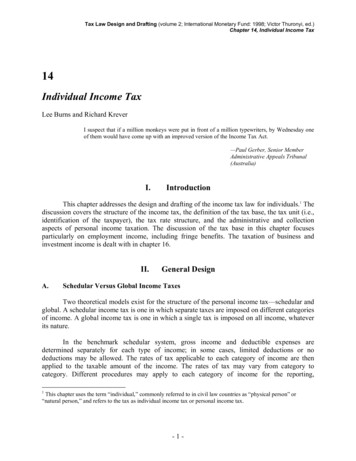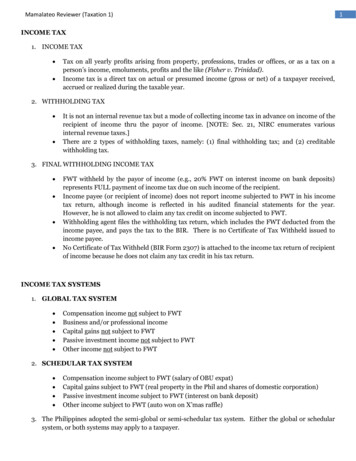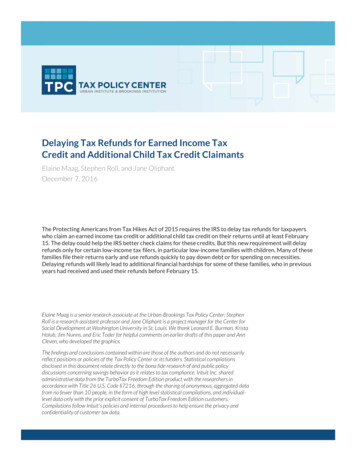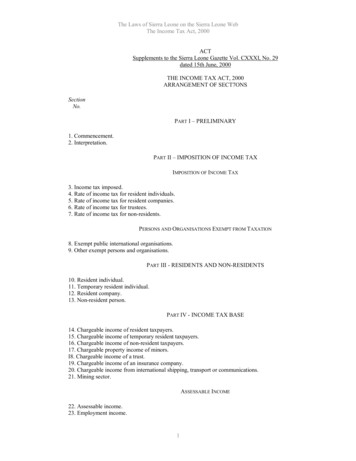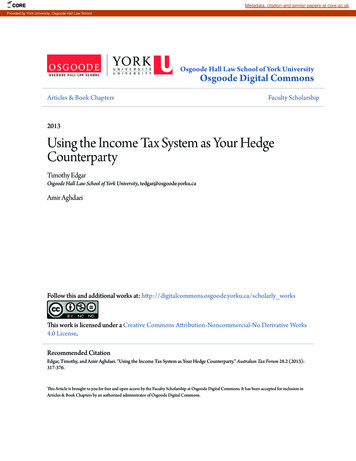
Transcription
COREMetadata, citation and similar papers at core.ac.ukProvided by York University, Osgoode Hall Law SchoolOsgoode Hall Law School of York UniversityOsgoode Digital CommonsArticles & Book ChaptersFaculty Scholarship2013Using the Income Tax System as Your HedgeCounterpartyTimothy EdgarOsgoode Hall Law School of York University, tedgar@osgoode.yorku.caAmir AghdaeiFollow this and additional works at: http://digitalcommons.osgoode.yorku.ca/scholarly worksThis work is licensed under a Creative Commons Attribution-Noncommercial-No Derivative Works4.0 License.Recommended CitationEdgar, Timothy, and Amir Aghdaei. "Using the Income Tax System as Your Hedge Counterparty." Australian Tax Forum 28.2 (2013):317-376.This Article is brought to you for free and open access by the Faculty Scholarship at Osgoode Digital Commons. It has been accepted for inclusion inArticles & Book Chapters by an authorized administrator of Osgoode Digital Commons.
Using the income tax system asyour hedge counterpartyTim Edgar* and Amir Aghdaei**AbstractA strain of the academic literature on taxation and risk taking emphasises the incomeeffect and consequent transfer of risk to government through the income tax systemin the presence of scaling of risky positions. The policy implications of this literaturehave been explored in considerable detail, although the practical significance for taxpolicymakers is ambiguous given the tax and non-tax constraints on scaling underthe personal income tax. In contrast, fragmentary transactional evidence suggeststhat scaling of risky positions may have its most practical application in the context ofcorporate hedging transactions where many of the same tax and non-tax constraintsdo not apply. In fact, risk-transfer transactions in this very different context have beenthe subject of some recent attention by tax policymakers and tax administrators.This paper explores the case for, and design of, a loss limitation intended to addressthe transfer of risk to government that otherwise is the result of hedged positionsthat are scaled to provide imperfectly offsetting pre-tax cash flows but perfectly (ornear perfectly) offsetting after-tax cash flows. Although the case for such a limitationextends broadly to the entire range of such transactions, perceptions of costlinessAcknowledgementsThe authors would like to thank Ben Alarie, Ed Kleinbard, Mike Kobetsky, and Leonard Nicita forcomments on an earlier draft. An anonymous referee also provided helpful suggestions.*Faculty of Law, Osgoode Hall Law School, York University and Faculty of Law, University of Sydney.**LLM Candidate, University of Sydney.This paper was accepted for publication on 25 February 2013.317
318 (2013) 28 AUSTRALIAN TAX FORUMassociated with the identification exercise, as well as perceptions of a negativeimpact on the decision to hedge, may lead to a more narrowly focused loss limitationpatterned on legislation recently adopted by UK Inland Revenue. For the much morelimited subset of risk-transfer transactions that are entered into for the purpose ofproviding a tax benefit, narrowly construed, general anti-tax avoidance rules and/ordoctrines can provide an effective response. An example of this type of transaction isthe asymmetric swap that is the subject of a taxation determination released by theAustralian Taxation Office (ATO).IIntroductionIn Taxation Determination TD 2010/12,1 the Australian Taxation Office (ATO) ruledthat the general anti-avoidance rule in Part IVA of the Income Tax Assessment Act 1936(ITAA 1936) can apply to an asymmetric swap scheme. These schemes, implementedby a number of Australian banks, received some attention in the popular press2 whenthe ATO first released Draft Taxation Determination TD 2009/D12,3 the predecessor toTD 2010/12. But the asymmetric swap that is the subject of this taxation determinationis only one particular example of a broader set of transactions structured to transfermarket risk to government through the income tax system. In fact, we understandthat the Canada Revenue Agency (CRA) and the US Internal Revenue Service(IRS) are both currently examining similar transactions under audit. It is perhapsnot surprising, therefore, that the Organisation for Economic Co-operation andDevelopment (OECD) has also recently released a report highlighting the revenuethreat from these transactions and canvassing possible responses.4 Such transactionsare sometimes referred to as “after-tax hedging” or “over-hedging”/“under-hedging.”1234ATO, Taxation Determination TD 2010/12, “Income tax: can Part IVA of the Income TaxAssessment Act 1936 apply to an asymmetric swap scheme?” 28 April 2010.See, for example, Richard Gluyas, “ATO Targets Banks’ Swap Deals” The Australian, 7 November2009. See also Ben Butler and Eric Johnston, “MacBank’s 250m Tax Perk at Risk” SydneyMorning Herald, 11 April 2011.ATO, Taxation Determination TD 2009/D12, “Income tax: can Part IVA of the Income TaxAssessment Act 1936 apply to an asymmetric swap scheme?” 14 October 2009.OECD, Aggressive Tax Planning based on After-Tax Hedging (Paris: OECD, March 2013), at 3and 7 (suggesting that hundreds of millions of USD revenue is at risk because of aggressivetax planning transactions based on after-tax hedging, with member countries identifying anumber of multi-billion USD transactions). See also OECD, Corporate Loss Utilisation throughAggressive Tax Planning (Paris: OECD, August 2011), at 51-52 (describing certain after-taxhedging transactions intended to transfer losses from low-tax to high-tax jurisdictions). Thereis no mention of the subject of after-tax hedging in the discussion paper, recently releasedby Australian Treasury, on proposed amendments to the taxation of financial arrangements(TOFA) tax hedging rules in subdivision 230-E of the Income Tax Assessment Act, 1997 (ITAA1997). See Australian Treasury Department, Improving the Operation of the Tax HedgingProvisions (Canberra: Commonwealth of Australia, Discussion Paper, February 2012). But seealso Australian Treasury Department, Budget Measures 2013-14 – Part 1: Revenue Measures
Using the income tax system as your hedge counterparty319But to better convey the associated policy problem, we use the term “risk-transfertransactions” to describe these transactions. Although this term could also includetransactions that transfer price risk through the market, we use the conventional term“hedge transaction” to distinguish them from those transactions that are the focus ofthis article.In contrast with the ATO’s reliance on Part IVA, UK Inland Revenue has recentlytargeted a subset of risk-transfer transactions (referred to as “risk-transfer schemes”)with the application of a loss limitation.5 Although the focus of this legislative responseis a broader set of transactions than the asymmetric swap considered in TD 2010/12,the ability to use government as an involuntary hedge counterparty through theincome tax system is not limited to either the kinds of transactions that are the focusof the ATO taxation determination or the narrowly targeted loss limitation adopted inthe United Kingdom. An income tax environment characterised by fixed asymmetrictax rates and non-binding loss limitations permits such risk transfer through scalingof the magnitude of pre-tax positions in a manner that provides imperfectly offsettingpre-tax cash flows but an effective after-tax hedge (that is, perfectly, or near perfectly,offsetting after-tax gain and loss). In short, with asymmetric tax rates, non-bindingloss limitations and scaling of offsetting long and short positions, government can bemade to bear the entirety of the relevant market risk reflected in the net tax liabilityassociated with the offsetting positions.There is surprisingly very little tax literature on scaling of positions in a hedge context.With the exception of the recent OECD report, noted above,6 what literature that doesexist tends to be technical in its focus and ignores any associated policy problem.7We emphasise that a generalised ability for corporate taxpayers to use the income taxsystem as their involuntary hedge counterparty presents a policy problem that requiresan income-tax based response, preferably in the form of a loss limitation applicable torisk-transfer transactions generally and not just the subset of such transactions thatare the focus of the UK legislative response. We suggest that a broad loss limitationapplicable to risk-transfer transactions generally is preferable, primarily because of theentirely random incidence that is the result of the conditions required to facilitate suchtransactions. These conditions provide absolutely no normatively compelling rationalethat would justify an acceptance of risk-transfer transactions by policymakers.Ideally, the kind of broad loss limitation we propose would be combined with a hedgetax accounting regime, which may mute, to some extent at least, the substitution ofrisk transfer through the income tax system for risk transfer through the market.567(Paper 2) (Canberra: Commonwealth of Australia, 14 May 2013), at 34-35 (indicating pendingamendments to the Offshore Banking Unit (OBU) regime to address unspecified integrity issues,which could extend to risk-transfer transactions effected through OBUs).UK Finance Act 2010, section 46 and schedule 16 enacting Part 21A, sections 937A to 937O, ofthe Corporation Tax Act 2010 applicable to accounting periods beginning on or after 1 April 2010.Aggressive Tax Planning based on After-Tax Hedging, supra note 4.See, for example, Michael Feder, “After-Tax Hedging” (2010) 126 Tax Notes 1613 (describingcircumstances in which income tax liabilities can be used to hedge risk).
320 (2013) 28 AUSTRALIAN TAX FORUMHowever, such a regime tends to be limited to the provision of symmetric timing andcharacter recognition of gain and loss associated with offsetting pre-tax positions; italso tends to be less than comprehensive in failing to apply in a cross-border context,and in some cases is elective.8 As a result, one of the conditions required for theimplementation of risk-transfer transactions – fixed asymmetric tax rates – holdsfor a broad range of corporate taxpayers, including financial institutions subject tomark-to-market recognition of gain or loss on non-capital account for traded assetsand derivative instruments.9 A broad loss limitation is arguably required, therefore,because of the incompleteness of application of hedge tax accounting regimes, leavinga range of corporate taxpayers with an effective option to transfer risk through theincome tax system rather than the market. The same loss limitation rule is alsorequired in the absence of a hedge tax accounting regime, since taxpayers retain thesame option in this legislative environment.Despite the policy case for the adoption of a broad loss limitation, perceivedcompliance and administrative costs associated with the identification of a wide set ofproblematic transactions, as well as perceptions of a negative impact on the decisionto hedge risk,10 may lead tax administrators and policymakers to distinguish: 8910risk-transfer transactions that do not provide a financial benefit otherthan the transfer of risk;The hedge tax accounting regime in ITAA 1997, subdivision 230-E reflects these features.Because it affects only timing and character of the recognition of gain and loss when taxpayerselect to have it apply, the Commissioner’s discretion to treat offsetting positions as a hedge in theabsence of a designation by the taxpayer would not disturb the effect of scaling in the presenceof asymmetric tax rates. See ITAA 1997, section 230-345 (permitting the Commissioner, undercertain conditions, to make a determination that the requirements of a hedge are met). The UShedge tax accounting regime providing character matching of gain and loss includes a “failedhedge rule,” which ensures that a taxpayer may not avoid non-capital treatment by failing toidentify transactions that are clearly hedge transactions. In the absence of a reasonable basis forfailing to identify a hedge transaction, gain (but not loss) may be treated as ordinary income.See Internal Revenue Code (IRC) Reg. section 1221-2(f)(2)(iii); and Edward D. Kleinbard andSuzanne F. Greenberg, “Business Hedges After Arkansas Best” (1988) 43 Tax Law Review 393.See, in this respect, Edward D. Kleinbard and Thomas L. Evans, “The Role of Mark-to-MarketAccounting in a Realization-Based Tax System” (1997) 75 Taxes: The Tax Magazine 788(characterising the application of mark-to-market reporting to the inventory of traders ordealers in securities as a substitute for a hedge accounting regime); and the elective financialreports method in ITAA 1997, subdivision 230-F and/or the elective fair value method in ITAA1997, subdivision 230-C.See, HM Revenue and Customs, “Technical Note on Overhedging and Underhedging,” 10 August2009, at 5 (“The Government recognises that there will be situations where groups are seekingto undertake commercial hedging transactions not covered by the present tax neutral hedgingprovisions. Where such situations arise there is no intention to prevent groups from undertakingoverhedging or underhedging transactions where this is the only realistic way to provide aneffective post tax hedge of the risk in question.”). See also Aggressive Tax Planning based onAfter-Tax Hedging, supra note 4, at 35 (suggesting that there is a policy-relevant distinctionbetween acceptable and unacceptable after-tax hedging).
Using the income tax system as your hedge counterparty321 risk-transfer transactions that provide a financial benefit other than thetransfer of risk or a tax benefit; and risk-transfer transactions that provide a tax benefit.Costliness of the identification exercise is particularly severe in a cross-border context,which commonly provides asymmetric tax rates necessary for scaling of offsettingpositions and the consequent transfer of risk through the income tax system. Wherea hedge tax accounting regime provides symmetric tax treatment for domestictransactions, the same identification exercise may not be as severe; yet tax policymakersmay be willing to tolerate a range of risk-transfer transactions on an apparent empiricalassumption that their implementation is limited. The same tolerance by policymakers,perhaps based on the same empirical assumption, is evident in those jurisdictionswhere a hedge tax accounting regime has not been adopted.To the extent that risk-transfer transactions have been the subject of any responseby tax policymakers and tax administrators, the apparent focus is what appears,intuitively at least, to be the more egregious transactions involving the transfer of riskthrough the income tax system and the provision of an additional financial advantageor a tax benefit. For the former type of risk-transfer transaction, a narrow losslimitation along the lines of that adopted in the United Kingdom is defensible. Forthe latter type of risk-transfer transaction, general anti-tax-avoidance rules or antitax-avoidance doctrines can provide an effective and defensible response. Indeed,because risk-transfer transactions of this type are nothing more than a particularexample of tax-avoidance transactions, the effectiveness of the response depends on acharacterisation of such transactions as carried out for the purpose of providing a taxbenefit. Negating the transfer of risk to government through the income tax systemis an entirely incidental effect of the application of general anti-tax-avoidance rulesand/or doctrines.Part two begins with a description of three representative risk-transfer transactionsillustrating, at a general level, the shared features of such transactions. Part threefollows with an articulation of the policy problem that is common to risk-transfertransactions. This part draws on the academic literature on taxation and risk takingwhich, despite a different focus, highlights the fact that the generalised policy problempresented by risk-transfer transactions is not unique to the subset of such transactionsthat, to date, have been the limited target of tax policymakers and tax administrators.Part four explores the design of a loss limitation applicable to risk-transfer transactionsgenerally. The suggested design features are contrasted with the UK loss limitation,which targets the narrower range of risk-transfer transactions that provide a financialbenefit other than a tax benefit and the transfer of risk through the income tax system.Part five concludes with a discussion of the application of general anti-tax-avoidancerules and/or doctrines to the even narrower range of risk-transfer transactions thatare entered into to provide a tax benefit. The reasoning in TD 2010/12 is critiqued asan example of the kind of conceptual and factual difficulties of application that arisein this context.
322 (2013) 28 AUSTRALIAN TAX FORUMIIIllustrative Risk-Transfer TransactionsA risk-transfer transaction is designed to substitute for another transaction in whicha taxpayer would otherwise: hedge market risk on a pre-tax basis by entering into short and longpositions11 with offsetting pre-tax cash flows; or assume the market risk associated with an unhedged short or longposition.In the former instance, symmetric treatment of the offsetting short and long positionsensures that no net tax is payable. In the latter instance, gain or loss is recognised atthe relevant tax rate and government shares the risk associated with the unhedgedposition in proportion to that rate.As hedge transaction substitutes, risk-transfer transactions share four features. First,they are structured to split offsetting short and long positions such that the twopositions are treated differently. Second, the magnitude of the offsetting positions areadjusted or scaled such that the pre-tax cash flows offset imperfectly. Third, scalingensures that the after-tax cash flows offset perfectly once gain and loss is subjectto the different treatment or, alternatively, that the market risk associated with anunhedged position is eliminated. Fourth, government effectively assumes the marketrisk reflected in the net tax liability associated with the imperfect pre-tax offset. In theabsence of adjustment of offsetting short and long positions to account for differenttax rates, market risk would be borne by market participants, with governmentsharing that risk as a function of the relevant tax rates.Each of these features of risk-transfer transactions is illustrated below. The first twotransactions are foreign-currency hedges described in a technical note released by UKInland Revenue in August 2009 in advance of the introduction of legislation intendedto address these and other similar transactions.12 The third example is an asymmetricswap, which is the subject of TD 2010/12.13111213An investor is “long in an asset” if he or she owns the asset or has the right or obligation topurchase it. In that case, the investor benefits if the asset appreciates in value and loses if the assetdepreciates. An investor is “short in an asset” if he or she has sold the asset or has the right orobligation to sell in the future. In that case, the investor benefits from any depreciation in valueof the asset and loses if the asset appreciates.Technical Note, supra note 10. See also Feder, supra note 7; and Aggressive Tax Planning basedon After-Tax Hedging, supra note 4, at 18-19.See also Aggressive Tax Planning based on After-Tax Hedging, supra note 4, at 24-27.
Using the income tax system as your hedge counterpartyA323Foreign-Currency HedgingExample 1Aco and Bco are members of the same corporate Group X and subject to a 28 percenttax rate. Aco invests 100m sterling (GBP) in yen-denominated (JPY) shares of asubsidiary, Subco. Group X would like to eliminate exchange rate risk attributable todepreciation of the JPY against GBP while also benefitting from yen interest rates thatare significantly lower than GBP interest rates. To realize these goals, Bco borrows theJPY-equivalent of 139m GBP.Figure 1139m GBPJPY-denominatedborrowingAco100m GBPJPY-denominatedsharesBcoSubcoThe hedge in example 1 is structured to provide asymmetric tax treatment of offsettingpositions in the form of a timing mismatch. Foreign exchange gain or loss on the yendenominated shares of Subco held by Aco is brought to account on realisation, whileoffsetting loss or gain on the yen borrowing of Bco is brought to account annually onthe retranslation basis. At an assumed corporate income tax rate of 28 percent, the yenborrowing is scaled up to the yen-equivalent of 139m sterling (100m x 100m/72m 139m) to provide a complete after-tax offset of unrealized gain or loss on the sharesof Subco. The combination of the asymmetric tax treatment of the offsetting positionsand the scaling up of the pre-tax borrowing allows Group X to borrow at the loweryen interest rate while eliminating exchange rate risk, which is effectively transferredto government through the income tax system. Under various changes in the sterling/yen exchange rate, this result is summarised in table 1.1.
324 (2013) 28 AUSTRALIAN TAX FORUMTable 1.1GBP/JPY-30%-20%-10%-5%5%10%20%30%Bco: FX gain/losson JPY 41.70Tax et after-tax(30)(20)(10)(5)5102030Aco: FX gain/lossSubco shares3020105(5)(10)(20)(30)Tax payable00000000Net ax00000000Net s an alternative to the hedge provided by the transaction in example 1, Aco couldborrow yen equal to the sterling amount of its yen-denominated shares. Provided thatforeign exchange gain or loss on the borrowing is taxed symmetrically with foreignexchange loss or gain on the yen-denominated shares, both the pre-tax and after-taxresult would be no net gain or loss and no net revenue payable to government. Thisresult is summarised in table 1.2.Table 1.2GBP/JPY-30%-20%-10%-5%5%10%20%30%Aco: FX gain/loss on sharesof Subco3020105(5)(10)(20)(30)Aco: FX gain/loss on JPYborrowing(30)(20)(10)(5)5102030Net revenue00000000Example 2Bankco and Holdco are members of the same corporate Group Y and subject to a28 percent tax rate. Holdco invests the JPY-equivalent of 100m GBP in a limitedpartnership that invests in JPY-denominated bonds. Holdco then enters into: (i)
Using the income tax system as your hedge counterparty325a currency swap with Bankco with a notional principal amount of 100m GBP; and(ii) a forward currency contract with Bankco in the amount of 39m GBP. Under boththe currency swap and forward currency contract, Holdco agrees to sell JPY for GBPat the current spot rate and also receives the difference between JPY and the higherGBP interest rates. Bankco offsets its positions with Holdco by entering into a mirrorcurrency swap and forward contract in the market whereby it agrees to sell JPY for GBP.Figure dHoldcoPartnersLP(JPY)JPY BondsAs with the transaction in example 1, the hedge in example 2 is structured to provideasymmetric tax treatment of offsetting positions in the form of a timing mismatch.Foreign exchange gain or loss on the yen-denominated bonds held by Holdco throughits limited partnership interest is brought to account on realisation in the form of gainor loss allocated to Holdco.14 Offsetting loss or gain on the currency swap and theforward contract with Bankco is brought to account on the closing out of the contracts,14Technical Note, supra note 10, at 5 (indicating that JPY is the functional currency of the limitedpartnership so that any exchange gain or loss on the bonds will not be recognised).
326 (2013) 28 AUSTRALIAN TAX FORUMwhich will precede realisation on the bonds.15 At an assumed corporate income taxrate of 28 percent, the forward contract is used to scale up Holdco’s foreign exchangeposition to the yen-equivalent of 139m sterling (100m x 100m/72m 139m), whichprovides a complete after-tax offset of unrealised gain or loss on the yen-denominatedbonds through the limited partnership interest. Under various changes in the sterling/yen exchange rate, the after-tax position of Holdco is summarised in table 2.1.Table )5102030Tax dco: FX gain/loss ax payable(3.30)(2.20)(1.10)(0.55)0.551.102.203.30Net after-tax(30)(20)(10)(5)5102030Holdco: FX gain/loss JPY bond3020105(5)(10)(20)(30)Tax payable00000000Net after-tax3020105(5)(10)(20)(30)Holdco: FX gain/loss currency swapBecause of its mirror positions under the currency swap and forward with Holdco andthe market, Bankco is perfectly hedged, both pre-tax and after-tax, and will realise nonet gain or loss. This result is summarised in table 2.2.15See Technical Note, supra note 10, at 5 (indicating that Holdco is accounting under old UKGAAP and is treating the currency swap as a hedge of the limited partnership interest broughtto account on realisation. The principal amount on the forward contract is treated as a hedge ofthe tax on the currency swap and is brought to account when the tax on the currency swap isbrought to account).
Using the income tax system as your hedge counterparty327Table 2.2GBP/JPY-30%-20%-10%-5%5%10%20%30%Bankco: FXgain/loss withHoldco3020105(5)(10)(20)(30)Bankco: FXgain/loss withmarket(30)(20)(10)(5)5102030Net after-tax00000000The hedge in example 2 differs from the hedge in example 1 in the form of the benefitrealised by the corporate group. The combination of the asymmetric tax treatmentof the offsetting positions and the scaling up of the pre-tax foreign exchangeposition allows Group Y to earn a return greater than the sterling interest rate whileeliminating exchange rate risk. This result is realised because of the off-market pricingof the currency swap and the forward. In particular, the exchange rate under bothcontracts is the spot exchange rate rather than a forward exchange rate that, in theory,reflects the interest rate differential of the two currencies.16 To bring the contracts onmarket, Bankco will receive, under its contracts with the market, the present value ofthe interest rate differential between the stronger yen and the weaker sterling. Bankcomust pay the same amount to Holdco under its off-market currency swap and forwardcontract with Holdco, which can invest the prepayment at the sterling interest rate.Holdco will thereby earn the lower interest rate on the yen-denominated bonds, plusthe sterling interest rate on the prepayment under the currency swap and forwardcontract, while eliminating its exchange rate risk. The total exceeds what wouldotherwise be interest earned on a sterling-denominated bond in the amount of 100mor, alternatively, interest plus expected foreign exchange gain on a yen-denominatedbond where unexpected gain or loss is hedged by Holdco selling yen forward at theforward exchange rate.As with the hedge in example 1, exchange rate risk otherwise borne by Group Y iseffectively transferred to government through the income tax system. This result issummarised in table 2.3.16The arbitrage pricing relationship, known as “covered interest-rate parity,” holds that thedifference between forward and spot exchange rates for two currencies must equal the differencebetween interest rates for borrowings/loans in the same currencies. This equivalence ensuresthat a borrowing/loan in a weak currency yields the same return as an equivalent borrowing/loan in a stronger currency. Covered interest-rate parity is expressed as:Ef/Es (1 ir)/(1 id)where Es is the spot exchange rate for two currencies; Ef is the forward exchange rate; ir is theinterest rate for the foreign currency; and id is the interest rate for the domestic currency.
328 (2013) 28 AUSTRALIAN TAX FORUMTable 2.3GBP/JPY-30%-20%-10%-5%5%10%20%30%Net revenue fromFX 8011.7000000000Consolidatedafter-taxBAsymmetric SwapExample 3Non-resident bank and resident bank are unrelated. To eliminate exposure associatedwith a 150m long position on an equity index, non-resident bank enters into twoswaps with resident bank. One swap (“the short swap”) is entered into with theoffshore banking unit (OBU) of resident bank, which is subject to a 10 percent taxrate. The short swap requires: (i) non-resident bank to pay the percentage decreasein value of a 525m notional amount of the index; and (ii) resident bank to pay thepercentage increase in value of the same notional principal. The other swap (“the longswap”) is entered into with resident bank’s domestic banking unit (DBU), which issubject to a 30 percent tax rate. The long swap requires: (i) non-resident bank to paythe percentage increase in value of a 675m notional amount of the index; and (ii)resident bank to pay the percentage decrease in value of the same notional principal.Figure 3NR Banklong swap 675mnotional principalshort swap 525mnotional principalOBUDBU
Using the income tax system as your hedge counterparty329Similar to the foreign-currency hedges in examples 1 and 2, the asymmetric swap inexample 3 is structured to provide asymmetric tax treatment of offsetting positions,but using different statutory tax rates rather than a timing mismatch. Gain or loss onthe short swap is brought to account at a 10 percent tax rate by the OBU of residentbank, while offsetting loss or gain on the long swap is brought to account at a 30percent tax rate by resident bank’s DBU. To provide the required hedge of non-residentbank’s long equity index position of 150m, the notional principal amounts of theshort and long swap positions are set to vary by this amount, but also incorporating atax-rate scaling of the relevant amounts. Scaling of the positions ensures that after-
4 OECD, Aggressive Tax Planning based on After-Tax Hedging (Paris: OECD, March 2013), at 3 and 7 (suggesting that hundreds of millions of USD revenue is at risk because of aggressive tax planning transactions based on after-tax hedging, with member countries identifying a number of multi-billion USD transactions).




